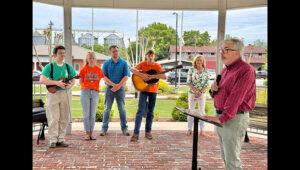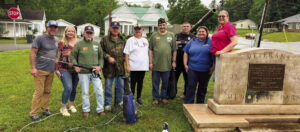The truth about elk hunting
By By Otha Barham / outdoors editor
Sept. 20, 2002
I stepped slowly ahead, Douglas fir branches brushing my face and dumping snow that sparkled in the morning sun as it sifted to the white ground below. I dared not use a hand to shield my face, both hands being indispensable for holding my rifle at ready. The elk had to be bedded within mere feet, because the small bench was only 30 yards across and I had already followed their tracks half that distance toward the edge.
They would be lying where they could see danger from below and catch the scent of trouble from the rear where I was stalking. Because at the moment I had the wind in my favor, they had not scented me. One more silent step in the snow and I heard them dive off the edge. I dashed ahead and peered down the mountain, listening to the loud crashes below as they broke deadfalls and dry aspen limbs in their descent. They had spotted me before I could see them.
On this late October hunt, I had cut the track of three elk in the snow about half way up Ute Peak in the Williams Fork Mountains of northern Colorado. One track was big enough to be a mature bull. Because bulls hang out together following the September/October rut, the odds were that the tracks were made by three bulls a big one and two juniors.
Upward I climbed, struggling through blowdowns and slippery rocks hidden by slick, fresh snow. Elk leave grassy basins at daybreak or earlier and climb steep, timbered slopes to bed very high for the day. Sometimes they climb almost until noon before bedding.
Hopeless descent
After I jumped them on the bench, I stumbled and slid after the descending elk, hoping with little faith that one of them would be confused or curious enough to stop and look back uphill providing me a shot. It was not to be. Down and down they plunged, leaving gashes in the snow sometimes six feet long as their hooves skidded through the snow to frozen ground and rocks underneath.
Half an hour later, at the bottom of the mountain, I found what I expected. The tracks made a left turn and then led me uphill right back up toward the timberline of Ute Peak. Elk do you that way. They lay a tempting trail in the snow for you to follow uphill until you are exhausted. Then they escape back downhill to set you up for a second climb and a cardiac arrest. This time I opted to skip the heart attack. I left the track in disgust and trudged off in a futile search for level ground.
Elk hunting can kill a well hunter and the weak or ill should not indulge.
Jim Zumbo once lived in New Jersey and traveled west to study at Utah State University. He fell in love with the wide open spaces of the western mountains and the game animals he hunted there. Jim has remained in the West where he hunts all wild game and writes about his adventures between lectures on elk hunting across the country. Those who read his works in Outdoor Life magazine and other publications have no trouble determining his favorite game animal. It is the elk; wapiti to Native Americans, and actually a member of the deer family that evolved on the plains and retreated to the mountains in the face of civilization.
Apt title
Few hunt elk as much as Jim Zumbo. The writer has published a book about elk hunting, the title of which gets to the point of my effort here. His title is "To Heck With Elk Hunting." I am certain he settled on the phrase after realizing that it was his most frequent quote at the end of his hunts. I, too, have uttered those words after many an elk hunt, with slight variations in wording and sometimes with the addition of certain adjectives.
And yet Zumbo keeps going back for more year after year, as do I. For when the great bulls begin tearing wrist-sized limbs from the juniper and fir trees every September to frighten lesser rivals, I want to be lurking nearby in the shadows of quaking aspens, listening to the thrashings. When they bellow their chilling screams of lust and defiance that echo off rimrock cliffs and ring across the sagebrush basins, I want to sense the fear of their challengers and the passion of their assembled harems.
And so I, and others so addicted, go in autumn to elk country that stretches beneath snowy peaks crowned by skies that bestow soaring eagles by day and an overabundance of stars by night. We find a chill in the air and gold in the shimmering aspen leaves and majestic bulls that elude us nine times in ten. And while our words curse the hunt at season's end, our minds and hearts are laying plans for next year.










